 |
| Hydrophyllum virginianum in springtime |
I noticed a few patches of Virginia Waterleaf (Hydrophyllum virginianum) in our woodland the other day--not the spring flowers, but the foliage.
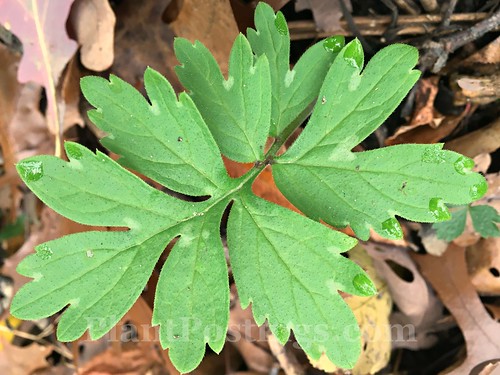 |
| Hydrophyllum virginianum this fall |
Normally they'd be dormant by now in my climate--either dried by parched late-summer days or liquefied by autumn frost. Neither has happened here ... yet.
It's been unseasonably warm and rainy through September and October. We still haven't had a frost (although some areas nearby have had a very light one). In any case, the Virginia Waterleaf is still green.
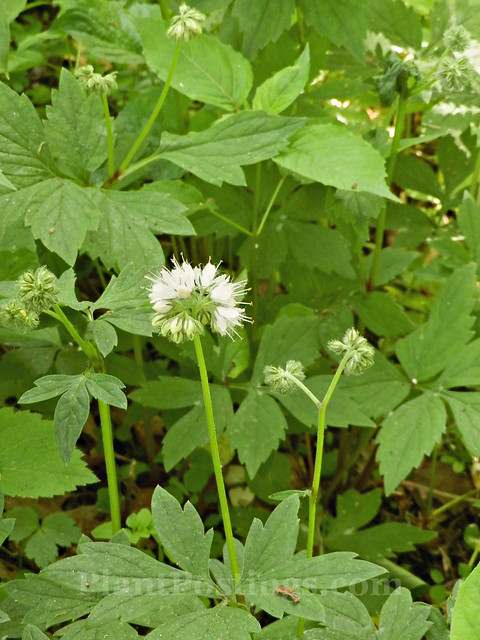
In the spring and summer, it's a hearty and hardy woodland garden plant. Some consider it a little "weedy," but our woodland is a bit wild. We tend to take a "hands-off" approach in this part of the property--removing only non-native invasive plants.
Virginia Waterleaf has a welcome home in the woodland and the woodland edge. It's a good placeholder to compete with Garlic Mustard (Alliaria petiolata), which is a non-native invasive that would take over the woods if not removed.
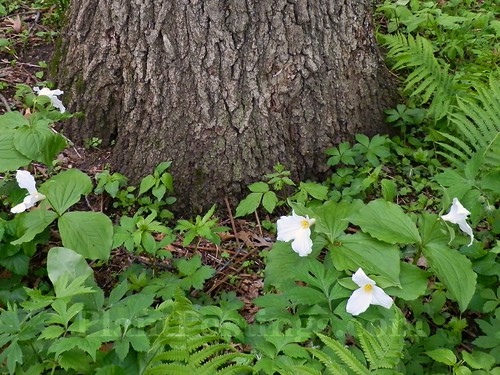
Virginia Waterleaf is a natural, pleasant companion to Trilliums, ferns, and other woodland plants. It's a fascinating little plant, really.

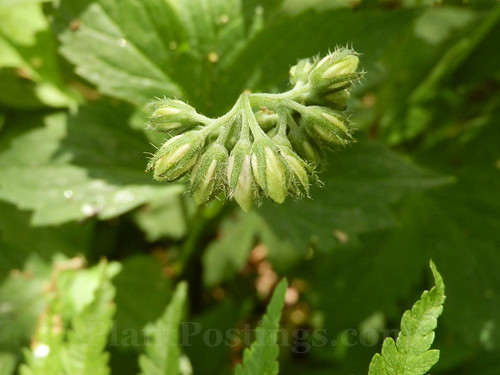
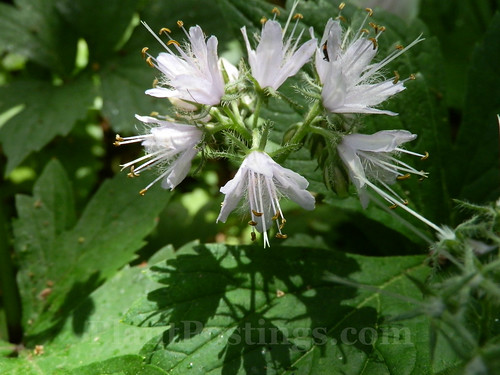
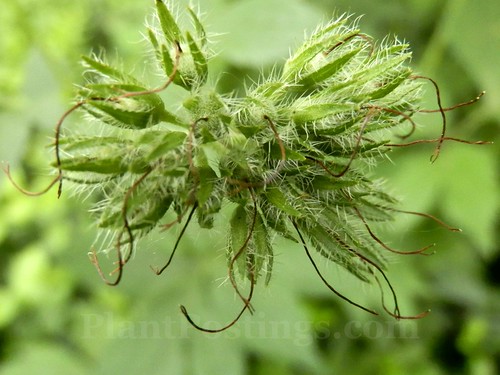
From emergence to bud, to bloom to seed, and beyond.
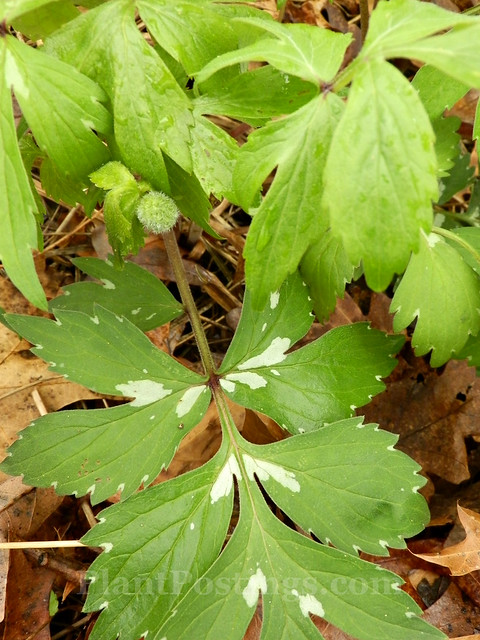
The name comes from the water-drop-like marks on the foliage.
Its native distribution extends through eastern North America--from Quebec to Manitoba, south through the Carolinas and west to Kansas, according to the Lady Bird Johnson Wildflower Center. Growing conditions include:
- Prefers part shade or shade;
- Thrives in rich, mesic soils;
- Spreads via rhizomes and seeds; and
- Is hardy in USDA zones 4-9.
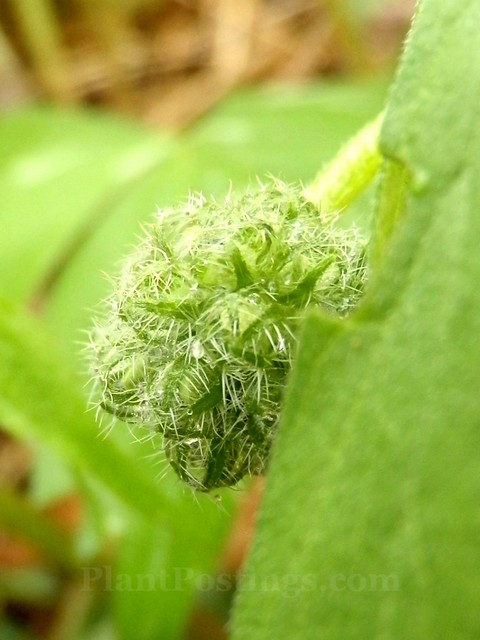
I find the tight buds particularly enchanting.

The five-petal flowers with hairy stamens and sepals are quite whimsical, and they welcome pollinators during their brief bloom time. The color ranges from white to a light lavender hue.
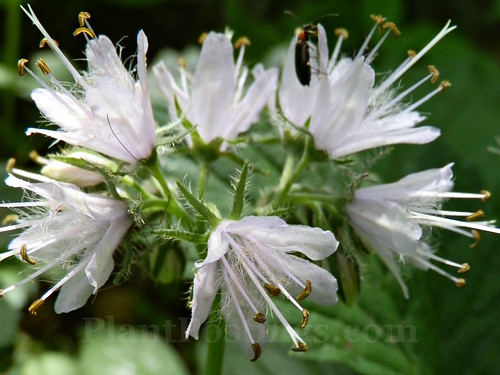
Over the years, my appreciation has grown for this fluffy native plant with "water-stained" foliage.
(Linking to Gail's Wildflower Wednesday, a few days late.)
Ah. love the green pics. Envious of your rain!
ReplyDeleteThanks, and gosh we've had so much rain (not complaining) I would gladly share some! I hope you get plenty of precipitation in the days ahead.
DeleteHow pretty! This is a totally new to me plant that I had never heard of before. I loved the photo of the waterleaf mixed with the trilliums and ferns at the foot of the tree - such a beautiful, natural co-mingling of plants.
ReplyDeleteI discovered it about a decade ago in the woodland. I actually think the foliage is more interesting than the flowers--until you get up close to the flowers. Their form is rather unusual, too. And it does mix well with the other woodland plants.
DeleteAbsolutely gorgeous ♥
ReplyDeleteThank you, Summer! It is a lovely plant.
DeleteIt's beautiful -- especially in your photos! I hadn't heard the explanation for the name ... makes sense :-)
ReplyDeleteThanks, Hollis. I thought I had some photos of the bumble bees on it, but all I could find in my files was the one with the scape moth. Yes, the leaves of this plant are unique!
Deletedelicately beautiful leaves, and I love the Trilliums!
ReplyDeleteThe foliage is fun and the flowers are pretty, too. And it's a very good companion for the Trilliums, which naturally occur, but which we want to encourage here! :)
DeleteI love your photos, Beth! I have a clump of this on the east side of our house, and deadhead them so they don't spread too far. I miss a few here and there, though.
ReplyDeleteThank you, Sue. I don't have any near the house, but they're certainly plentiful in the woods! That's a good idea to deadhead them if you don't want them to spread too much. I wonder if they'd be good cut flowers? I'm guessing not, because the flowers don't last long. But maybe if I cut them in the late bud phase? I'll have to try it next spring! :)
DeleteJust beautiful! And, is your garden still thriving even though it's autumn? I still have some summer plants that are giving all they've got! Oh, but the colors of fall, how enchanting they've been! Thank you for visiting my blog post!
ReplyDeleteThanks! Yes, I still have Zinnias, Cosmos, Pentas, and other annuals blooming. The Blue Mistflower has a few blooms, too. Today was an amazingly colorful, comfortable, and beautiful day here--73F, light breeze, and the Oaks and many of the Maples were at their peak of bright color! I agree: Autumn at its best is pretty awesome!
DeleteWhat a lovely little bloom! I've heard of the wildflower before, but didn't know much about it. Anything that can compete with garlic mustard is a winner in my book!
ReplyDeleteYes, re: the Garlic Mustard! The flower of V. Waterleaf was never a favorite, until this year. For some reason, they seemed so healthy and bright, and not quite as messy as I remember them. I love the foliage, though--particularly when it first emerges in the spring.
DeleteThe close-up shot reveals details it would be easy to miss...as is true of so many wildflowers.
ReplyDeleteYes, I agree. Sometimes from a distance, they can seem underwhelming (some wildflowers, anyway). But if you examine them closely, they're incredibly fascinating.
DeleteI'm not familiar with this wildflower. Thanks for sharing about it. Interesting to see a plant with natural variegation. Great photos as always.
ReplyDeleteYou are welcome, and thank you! The foliage is particularly interesting, in my opinion. The flowers are kinda unique, too.
DeleteI consider this a hideous monster in my garden so it was a bit of an education to realize not everone may see it that way.
ReplyDeleteOh, that's too bad. I admit, it wasn't a favorite for me until recently--when I realized its value to pollinators. Also, it helps me fight Garlic Mustard in the woodland. This summer I even found the blooms strangely beautiful. I've always enjoyed the foliage, though--especially in the springtime when it first emerges. :)
DeleteI too have it still peeking up here and there. It is such an unusual summer/fall this year. Record high temps, low rain fall. What will winter bring?? We will just have to wait and see.
ReplyDeleteYes, the weather is crazy! I find it fascinating, though, that you've had limited rainfall and we've had plenty--even though we don't live far apart. Gosh, I'm kind of afraid to think about what this winter will bring!
DeleteI have seen this one in the woods on one of our favorite hiking trails in the Blue Hills.
ReplyDeleteCan you believe this Wisconsin weather? 61 degrees November 1st! I just planted a garlic garden. ;-)
I have been busy planting spring bulbs. I also started a new peony garden.
I still would like to do some more, so I am giddy about our Wisconsin forecast for this week. :-)
I enjoy seeing V. Waterleaf in the woods during hikes! We hit 73F today! It was so comfortable, I had the windows open most of the day. And I even sat on the front porch for a while--a little treat for myself after raking Oak leaves for a couple of hours. So many more leaves to rake!! But the weather and the forecast are awesome!
DeleteI hadn't heard of this one before - it's quite pretty! I love seeing native woodland blooms. What an unusual year for weather it's been.
ReplyDeleteReally wonderful post . . .
ReplyDeleteWith your photo touch!
How pretty, it is a new one to me.
ReplyDelete